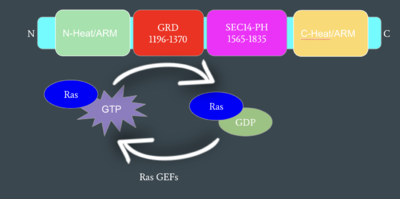Sandbox Reserved 1710
From Proteopedia
(Difference between revisions)
| Line 13: | Line 13: | ||
*<scene name='90/904315/Catalytic_triade/1'>Zinc Triade</scene> | *<scene name='90/904315/Catalytic_triade/1'>Zinc Triade</scene> | ||
=== Open Conformation === | === Open Conformation === | ||
| - | The other conformation that characterizes Neurofibromin is the <scene name='90/904315/Open_conformation/2'>Open Conformation</scene>. In the open conformation of Neurofibromin, the protein is considered active and is participating in its function of Ras regulation. This occurs because the | + | The other conformation that characterizes Neurofibromin is the <scene name='90/904315/Open_conformation/2'>Open Conformation</scene>. In the open conformation of Neurofibromin, the protein is considered active and is participating in its function of Ras regulation. This occurs because the transition metal-binding site with zinc no longer is able to form due to an increase in distance between the C1032, H1558 and H1576 residues that form the <scene name='90/904315/Open_conformation_triade/3'>Open Triade</scene>. One protomer in Neurofibromin has its GRD and Sec14-PH domains oriented in way that is almost reversed in position compared to the closed conformation. Due to this rotation, C1032 is now located too far away, approximately 30 Angstroms, from H1558 and H1576 which results in the loss of the metal-binding site. The lack of the transition metal-binding site allows the GRD to orient itself in such a way that it can associate with <scene name='90/904315/Ras_open_conformation/1'>Ras in the Open Conformation</scene>. |
| - | + | ||
| - | + | ||
*<scene name='90/904315/Open_conformation_arginine_fin/1'>Arginine Finger</scene> | *<scene name='90/904315/Open_conformation_arginine_fin/1'>Arginine Finger</scene> | ||
*<scene name='90/904315/Ras_open_conformation_with_arg/1'>Ras with Open Conformation and Arginine Finger</scene> | *<scene name='90/904315/Ras_open_conformation_with_arg/1'>Ras with Open Conformation and Arginine Finger</scene> | ||
Revision as of 18:57, 28 March 2022
| This Sandbox is Reserved from February 28 through September 1, 2022 for use in the course CH462 Biochemistry II taught by R. Jeremy Johnson at the Butler University, Indianapolis, USA. This reservation includes Sandbox Reserved 1700 through Sandbox Reserved 1729. |
To get started:
More help: Help:Editing |
Human Neurofibromin - The Tumor Suppressor Gene
| |||||||||||
References
- ↑ Naschberger A, Baradaran R, Rupp B, Carroni M. The structure of neurofibromin isoform 2 reveals different functional states. Nature. 2021 Nov;599(7884):315-319. doi: 10.1038/s41586-021-04024-x. Epub 2021, Oct 27. PMID:34707296 doi:http://dx.doi.org/10.1038/s41586-021-04024-x
- ↑ Trovo-Marqui AB, Tajara EH. Neurofibromin: a general outlook. Clin Genet. 2006 Jul;70(1):1-13. doi: 10.1111/j.1399-0004.2006.00639.x. PMID:16813595 doi:http://dx.doi.org/10.1111/j.1399-0004.2006.00639.x
- ↑ Lupton CJ, Bayly-Jones C, D'Andrea L, Huang C, Schittenhelm RB, Venugopal H, Whisstock JC, Halls ML, Ellisdon AM. The cryo-EM structure of the human neurofibromin dimer reveals the molecular basis for neurofibromatosis type 1. Nat Struct Mol Biol. 2021 Dec;28(12):982-988. doi: 10.1038/s41594-021-00687-2., Epub 2021 Dec 9. PMID:34887559 doi:http://dx.doi.org/10.1038/s41594-021-00687-2

